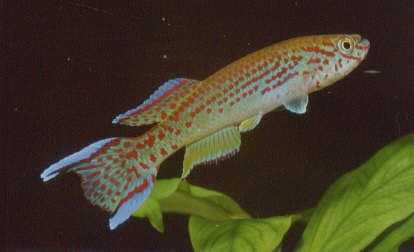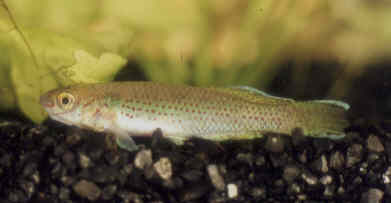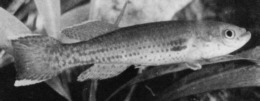Fundulopanchax gardneri lacustris (Radda 1974)

Lake Ejagham. Photo courtesy of Ed Pürzl.
| Meaning of Name |
After lacustris meaning to come from the lake (Ejagham). | ||||||||||||
| First Description |
Radda A.C. 1974 (Aphyosemion gardneri lacustre). Studien zur Cytogenetik, Taxonomie und Verbreitung der 'Gardneri-Gruppe' der Gattung Aphyosemion (Osteichthyes: Cyprinodontidae) aus dem südlichen Westkamerun. Jahrbuch des Naturhistorisches Museum der Stadt Bern 5: p 4-6. figure 1B, 3. | ||||||||||||
| Size |
54 mm (according to first description). | ||||||||||||
| Meristics |
D = 15-16, A = 15-17, D/A = +3-4, ll = 31-32 +2-3 (Radda 1974) | ||||||||||||
| Karyotype |
| ||||||||||||
| Sub-Genus |
Paraphyosemion | ||||||||||||
| Group |
gardneri | ||||||||||||
| Synonyms |
| ||||||||||||
Populations
|
Lake Ejagham - Lake Ejagham
is situated just south of Eymojok. It is treated by local peoples
as a sacred lake supposed to be haunted by the ghosts of past ancestors.
It lies at the centre of 13 salt springs. Ejagham is split into 3
words - “Ekub” (a whole or parcel), “Ejag” (is
split or broken), ‘ Haam” (is infinite or without end).
Basically refers to a splitting of the local tribe which is striving
for reunification.
C 89 / 5 - Collected by Wolfgang Eberl, Oliver Legros & Bas Vlijm, July 1989 in a stream found by walking through an experimental plantation & along a hard to follow trail for 500 metres. Ten pairs of young fish were collected. Other fish found were cichlids & barbs.
Radda's 1970's Collections - I am placing these photos here mainly because they looked very similar & also the time the photos were taken.
| ||||||||||||
| Type Locality |
An outlet of Lake Ejagham near Eyoumojok in the Ossidinge area.They were found in small pools of a drying tributary. | ||||||||||||
| Distribution |
Restricted to the area of Lake Ejagham, western Cameroon. | ||||||||||||
| Habitat |
Small pools, streams & brooks originating from Lake Ejagham. Some of these pools are most likely to be seasonal. | ||||||||||||
| Distinguishing Characteristics | Easily distinguished from other gardneri forms. The basic body colouration is green. The red spots on the body are small & are arranged in broken lines. This is perhaps the least colourful of all gardneri forms. | ||||||||||||
| Colour/Pattern Variability | Low. Scheel in ROTOW II described the anal fin as being greenish yellow to orange which may exhibit a row of small red spots in the basal area. |
||||||||||||
| History |
Found in 1970 by A.C.Radda in pools of a drying outlet of Lake Ejagham. | ||||||||||||
| Breeding Notes |
This
is perhaps the most difficult of all the gardneri
sub-species to breed. Some reports suggest that this type is best spawned in cool
water while others suggest that they only spawn at certain times of the year.
I must admit defeat with this one, having tried many years ago. All attempts to
spawn them ended in defeat & I decided to pass them on to a fellow killie
keeper to see if they would do better in his water. They are regarded as more of an annual than most 'gardneri' with eggs taking 4 weeks of semi-dry storage to hatch. Fred Wright observed that most of those hatching in this period were observed to be males in BKA newsletter No.100, December 1973. It was noted that if this peat was left submerged in water for a further period the hatching fry turned out to be mostly females. Alan Green bred this subsp. in the '80's in 2' (60 cm) deep tanks but had few eggs. Water temperature approx. 73°F. | ||||||||||||
| Diameter of Egg | 1.3 mm | ||||||||||||
| Remarks |
I have never been comfortable with the view that the Lake Ejagham gardneri are all lacustre but I put all these photos on this page for now. |





